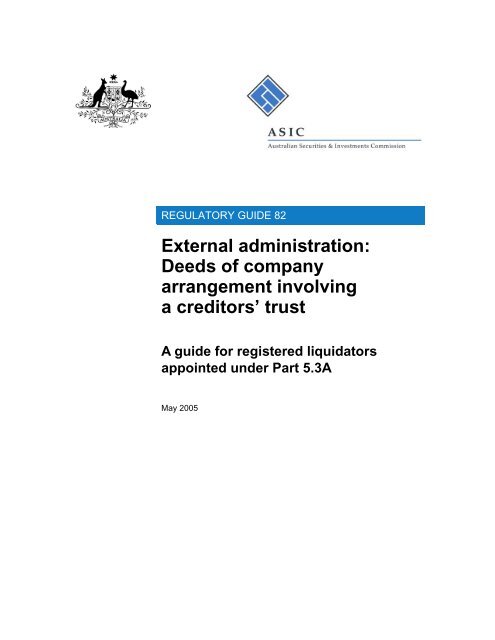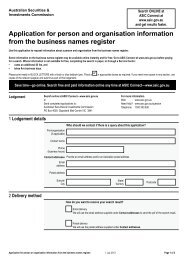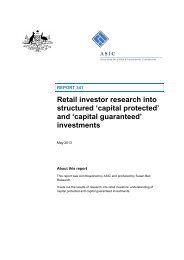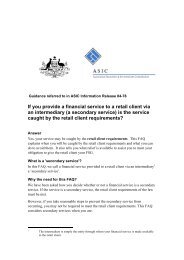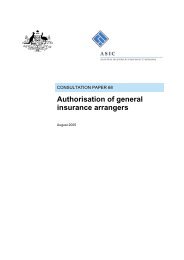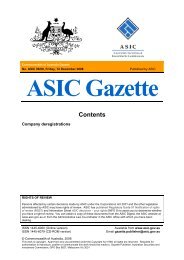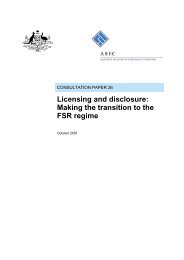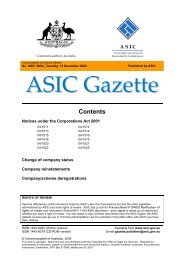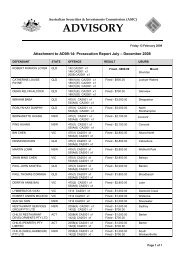External administration: Deeds of company arrangement involving a ...
External administration: Deeds of company arrangement involving a ...
External administration: Deeds of company arrangement involving a ...
You also want an ePaper? Increase the reach of your titles
YUMPU automatically turns print PDFs into web optimized ePapers that Google loves.
REGULATORY GUIDE 82<br />
<strong>External</strong> <strong>administration</strong>:<br />
<strong>Deeds</strong> <strong>of</strong> <strong>company</strong><br />
<strong>arrangement</strong> <strong>involving</strong><br />
a creditors’ trust<br />
A guide for registered liquidators<br />
appointed under Part 5.3A<br />
May 2005
Important note<br />
This guide is limited to certain conduct issues for registered liquidators appointed under<br />
Part 5.3A as a voluntary administrator or deed administrator (administrator), where a<br />
proposed deed <strong>of</strong> <strong>company</strong> <strong>arrangement</strong> (DCA) or proposed variation <strong>of</strong> a DCA<br />
(collectively, a DCA proposal) involves a creditors’ trust. It is not intended to be<br />
comprehensive and does not describe ASIC’s views about how administrators, or all<br />
registered liquidators, should perform all their relevant duties and functions.<br />
This guide does not constitute legal advice. Registered liquidators should seek their own<br />
advice to confirm how the law applies to them. It is the responsibility <strong>of</strong> each registered<br />
liquidator to identify the precise nature <strong>of</strong> their obligations from time to time under the<br />
Corporations Act, the Corporations Regulations and the general law, and to determine<br />
what they must do to perform adequately and properly all their duties and functions.
REGULATORY GUIDE 82: <strong>External</strong> <strong>administration</strong>: DCAs <strong>involving</strong> a creditors’ trust<br />
What this guide is about<br />
1 This guide is for registered liquidators appointed under Part 5.3A<br />
<strong>of</strong> the Corporations Act 2001 (Act) as a voluntary administrator or deed<br />
administrator (administrator).<br />
2 It explains:<br />
(a) our interpretation <strong>of</strong> administrators’ obligations under s439A,<br />
445F, 1292(2) and the general law where they are considering a<br />
proposed deed <strong>of</strong> <strong>company</strong> <strong>arrangement</strong> (DCA) or a proposed<br />
variation <strong>of</strong> a DCA (collectively, a DCA proposal) <strong>involving</strong> a<br />
creditors’ trust; and<br />
(b) in particular, the information that we consider is material to<br />
creditors and should therefore be disclosed when a DCA proposal<br />
involves a creditors’ trust.<br />
Why has ASIC issued this guide?<br />
3 The use <strong>of</strong> creditors’ trusts in DCAs is a relatively recent practice<br />
that appears to be increasing. We have issued this guide to outline our<br />
current views on this practice and indicate our interpretation <strong>of</strong> adequate<br />
and proper performance by administrators <strong>of</strong> their duties and functions in<br />
this situation.<br />
4 We are concerned that administrators appear not to be aware <strong>of</strong> or<br />
are not properly considering all the relevant issues raised by the use <strong>of</strong> a<br />
creditors’ trust. As a result, they may:<br />
(a) submit to creditors a DCA proposal that involves a creditors’ trust<br />
without properly considering whether such an <strong>arrangement</strong> is<br />
appropriate in the <strong>company</strong>’s circumstances; and/or<br />
(b) fail to disclose all the material information about the creditors’ trust<br />
and its implications to enable creditors to consider the advantages<br />
and disadvantages <strong>of</strong> this type <strong>of</strong> <strong>arrangement</strong> for them; and/or<br />
(c) make an inappropriate recommendation about the DCA proposal.<br />
5 We consider that DCA proposals should not involve creditors’ trusts<br />
unless administrators have adequately considered the appropriateness <strong>of</strong><br />
using a creditors’ trust in the particular case, and the advantages and<br />
disadvantages for the <strong>company</strong>, the creditors and the administrator.<br />
6 DCAs <strong>involving</strong> a creditors’ trust create special risks for creditors.<br />
Further, using a creditors’ trust in a DCA in some cases may be an abuse <strong>of</strong><br />
the Part 5.3A process or be otherwise contrary to the public interest. As a<br />
result, our view is that while the use <strong>of</strong> a creditors’ trust in a DCA may<br />
occasionally be justified by the circumstances <strong>of</strong> a particular <strong>company</strong>,<br />
indiscriminate use <strong>of</strong> creditors’ trusts in DCAs is not appropriate.<br />
© Australian Securities and Investments Commission, May 2005<br />
Page 3
REGULATORY GUIDE 82: <strong>External</strong> <strong>administration</strong>: DCAs <strong>involving</strong> a creditors’ trust<br />
Why follow this guide?<br />
7 This guide indicates how we think administrators will perform their<br />
obligations where a DCA proposal involves a creditors’ trust, if they are<br />
adequately and properly performing all their duties and functions.<br />
8 We will generally consider that an administrator has not complied<br />
with all their obligations under the Act and the general law if an<br />
administrator asks creditors to vote on a DCA proposal <strong>involving</strong> a<br />
creditors’ trust and the administrator has not followed this guide in a<br />
material respect.<br />
9 In such cases, we may:<br />
(a) make an application to the court for the relevant DCA to be<br />
terminated or avoided; and/or<br />
(b) seek specific orders against the administrator under s445D, 445G,<br />
447A, 447E(1) and/or 1321 as appropriate.<br />
10 In addition or alternatively, if we consider that the administrator<br />
has not adequately and properly performed their duties or functions as a<br />
registered liquidator (or is otherwise not fit and proper to remain a<br />
registered liquidator), we may make an application to the Companies<br />
Auditors and Liquidators Disciplinary Board (CALDB) under s1292(2)<br />
for cancellation or suspension <strong>of</strong> the administrator’s status as a registered<br />
liquidator. The CALDB may also impose other sanctions under s1292(9).<br />
11 Where a s439A report or s445F notice referring to a DCA proposal<br />
<strong>involving</strong> a creditors’ trust has already been sent to creditors but the<br />
relevant creditors’ meeting has not been held before publication <strong>of</strong> this<br />
guide, administrators should give creditors as much additional<br />
information referred to this guide as it is reasonably practicable for the<br />
administrator to provide in the time between publication <strong>of</strong> this guide and<br />
the creditors’ meeting.<br />
© Australian Securities and Investments Commission, May 2005<br />
Page 4
REGULATORY GUIDE 82: <strong>External</strong> <strong>administration</strong>: DCAs <strong>involving</strong> a creditors’ trust<br />
Contents<br />
What this guide is about ...........................................3<br />
Why has ASIC issued this guide? ..........................................3<br />
Why follow this guide? .........................................................4<br />
Section 1: DCAs and creditors’ trusts........................6<br />
What is a creditors’ trust? ....................................................6<br />
What are the special risks for creditors? .............................. 7<br />
What are the obligations <strong>of</strong> administrators?.........................8<br />
‘Holding’ DCAs and ‘self-executing’ creditors’ trusts............11<br />
Section 2: Disclosing material information.................... 13<br />
What is material information? ........................................... 13<br />
Reasons.............................................................................. 16<br />
Key events .......................................................................... 16<br />
Return to creditors............................................................. 16<br />
Trustee particulars..............................................................17<br />
Remuneration and expenses .............................................. 18<br />
Indemnities........................................................................ 18<br />
Powers ............................................................................... 19<br />
Claims ................................................................................ 19<br />
Other creditor/beneficiary differences............................... 19<br />
GEERS ...............................................................................20<br />
Compliance opinion ...........................................................20<br />
Solvency statement ............................................................ 21<br />
Taxation etc (<strong>company</strong> and trust)....................................... 21<br />
Taxation (creditor/beneficiary).......................................... 21<br />
Other.................................................................................. 21<br />
Key terms...............................................................23<br />
© Australian Securities and Investments Commission, May 2005<br />
Page 5
REGULATORY GUIDE 82: <strong>External</strong> <strong>administration</strong>: DCAs <strong>involving</strong> a creditors’ trust<br />
Section 1: DCAs and creditors’ trusts<br />
What is a creditors’ trust?<br />
1.1 A creditors’ trust in a DCA is a mechanism used to accelerate a<br />
<strong>company</strong>’s exit from external <strong>administration</strong>. To date, it has been used<br />
most commonly (but not exclusively) in connection with the<br />
rehabilitation <strong>of</strong> public companies listed on Australian Stock Exchange<br />
Ltd (ASX). In some cases, this leads to a ‘backdoor’ listing.<br />
1.2 Typically, under the terms <strong>of</strong> the DCA and one or more<br />
interconnected deeds, a trust entity is created and the <strong>company</strong>’s<br />
obligations to some or all <strong>of</strong> the creditors bound by the DCA are<br />
compromised and transferred to the trust. Those creditors become<br />
beneficiaries <strong>of</strong> the trust. Occasionally, there may be separate creditors’<br />
trusts for employee and non-employee creditors, or for secured and<br />
unsecured creditors.<br />
1.3 The <strong>company</strong> and/or third parties promise to make one or more<br />
payments (or transfer other property) to the trustee in satisfaction <strong>of</strong> the<br />
creditors’ claims against the <strong>company</strong>. In return, the creditors’ rights<br />
against the <strong>company</strong> are extinguished.<br />
1.4 The trustee <strong>of</strong> the new trust becomes solely responsible to the<br />
former creditors (now beneficiaries) for:<br />
(a)<br />
(b)<br />
(c)<br />
ensuring that the <strong>company</strong> and/or other third parties perform their<br />
payment and other obligations to the trustee;<br />
determining how much each <strong>of</strong> the former creditors is entitled to<br />
receive from the trust; and<br />
in due course, making any distribution to those former creditors.<br />
1.5 Usually, the DCA is ‘effectuated’ (and terminates) after the<br />
creditors’ claims against the <strong>company</strong> have been removed in this way. In<br />
most cases, the DCA terminates immediately upon creation <strong>of</strong> the trust,<br />
which usually occurs when or shortly after the DCA is executed.<br />
1.6 When the DCA terminates, the <strong>company</strong> ceases to be externally<br />
administered, the directors regain full control <strong>of</strong> the <strong>company</strong> and the<br />
<strong>company</strong> is no longer required to use the notification ‘subject to deed <strong>of</strong><br />
<strong>company</strong> <strong>arrangement</strong>’ on its public documents as otherwise would be<br />
required by s450E(2) <strong>of</strong> the Act.<br />
© Australian Securities and Investments Commission, May 2005<br />
Page 6
REGULATORY GUIDE 82: <strong>External</strong> <strong>administration</strong>: DCAs <strong>involving</strong> a creditors’ trust<br />
What are the special risks for creditors?<br />
1.7 We consider that there are different and additional risks for<br />
creditors where a DCA proposal involves a creditors’ trust. The<br />
significance <strong>of</strong> the risks in a particular case will depend on the quality <strong>of</strong><br />
the information the administrator provides to creditors and the actual<br />
terms <strong>of</strong> the DCA, trust deed and any other related documentation.<br />
1.8 The key additional risks are that:<br />
(a) under the DCA proposal, the DCA may be ‘effectuated’ and<br />
creditors’ rights against the <strong>company</strong> extinguished before:<br />
(i) the amount available for distribution to creditors <strong>of</strong> the<br />
<strong>company</strong>/beneficiaries <strong>of</strong> the trust has been ascertained; or<br />
(ii) the trust fund has been received in full by the trustee; or<br />
(iii) creditors <strong>of</strong> the <strong>company</strong>/beneficiaries <strong>of</strong> the trust have received<br />
any payment from either the deed administrator or the trustee;<br />
(b) creditors may have less (or no) legal rights if the DCA proposal is<br />
not fully complied with by all relevant parties; and<br />
(c) creditors may agree to the DCA proposal without being aware (or<br />
fully appreciating the implications) <strong>of</strong> these matters.<br />
1.9 The following factors increase the severity <strong>of</strong> these risks:<br />
(a) creditors’ lack <strong>of</strong> knowledge and inexperience;<br />
Note: The use <strong>of</strong> a creditors’ trust in a DCA will be beyond the reasonable<br />
contemplation or experience <strong>of</strong> most creditors bound by the DCA. Creditors<br />
(particularly unsecured creditors) <strong>of</strong> an insolvent <strong>company</strong> usually have limited<br />
knowledge <strong>of</strong> (or previous experience with) corporate insolvency laws and processes.<br />
Any previous experience is likely to be with the Act and ASIC as the relevant<br />
regulator, and they will generally expect their claims against the <strong>company</strong> and their<br />
dealings with the external administrator to be governed by the Act. Many creditors will<br />
have no or limited knowledge <strong>of</strong> trust law.<br />
(b)<br />
(c)<br />
(d)<br />
(e)<br />
(f)<br />
(g)<br />
inadequate disclosure by administrators <strong>of</strong> material information<br />
about the DCA proposal;<br />
the additional complexity <strong>of</strong> the legal and documentary <strong>arrangement</strong>s<br />
needed to support the use <strong>of</strong> a creditors’ trust under a DCA;<br />
the trustee’s identity, skills, remuneration and insurance <strong>arrangement</strong>s;<br />
non-uniformity <strong>of</strong> the State and Territory Trustee Acts governing<br />
trusts and trustees;<br />
differences in the ways trustees and registered liquidators are<br />
regulated and supervised, particularly by ASIC and the courts;<br />
potential difficulties for ASIC and creditors (as beneficiaries <strong>of</strong> the<br />
trust) in monitoring and enforcing proper conduct by the trustee; and<br />
© Australian Securities and Investments Commission, May 2005<br />
Page 7
REGULATORY GUIDE 82: <strong>External</strong> <strong>administration</strong>: DCAs <strong>involving</strong> a creditors’ trust<br />
(h)<br />
legal uncertainties and other issues for ASIC, creditors bound by<br />
the DCA or other persons in challenging a DCA that has already<br />
terminated.<br />
What are the obligations <strong>of</strong> administrators?<br />
1.10 Administrators have an overriding obligation to perform adequately<br />
and properly their duties and functions: s1292(2). This includes ensuring<br />
that the interests <strong>of</strong> creditors are adequately protected. Where a DCA<br />
proposal is concerned, we consider that an administrator who is fulfilling<br />
this obligation will:<br />
(a)<br />
(b)<br />
(c)<br />
evaluate the proposal before submitting it to creditors (see<br />
paragraphs 1.11–1.14);<br />
disclose all material information about the proposal to creditors<br />
(see paragraphs 1.15–1.18); and<br />
express an opinion about the proposal that adequately protects the<br />
interests <strong>of</strong> creditors (see paragraphs 1.19–1.22).<br />
Evaluating the proposal<br />
1.11 Before submitting any DCA proposal to creditors, administrators<br />
should consider whether there is a proposal suitable for submission. For<br />
example, it will rarely be appropriate for an administrator to submit to<br />
creditors a DCA proposal where the administrator does not have<br />
sufficient concrete details to comply with all their disclosure obligations:<br />
see paragraphs 1.15–1.18.<br />
1.12 Where the DCA proposal involves a creditors’ trust, administrators<br />
should specifically consider whether such a mechanism is appropriate in<br />
the <strong>company</strong>’s circumstances. We think this includes considering<br />
whether the DCA proposal (if accepted) may be an abuse <strong>of</strong> Part 5.3A or<br />
otherwise contrary to the public interest. If so, it may be appropriate for<br />
the administrator to seek directions from the court before submitting the<br />
DCA proposal to creditors.<br />
1.13 It has been asserted to ASIC that s435A (particularly paragraph (a))<br />
always justifies the use <strong>of</strong> creditors’ trusts in DCAs.<br />
Note: Section 435A states that the object <strong>of</strong> Part 5.3A is for the business, property and<br />
affairs <strong>of</strong> an insolvent <strong>company</strong> to be administered in a way that:<br />
(a) maximises the chances <strong>of</strong> the <strong>company</strong>, or as much as possible <strong>of</strong> its business,<br />
continuing in existence; or<br />
(b) if that is not possible, results in a better return for the <strong>company</strong>’s creditors and<br />
members than would result from an immediate winding up <strong>of</strong> the <strong>company</strong>.<br />
1.14 In our view, s435A does not justify in a DCA every kind <strong>of</strong><br />
mechanism that would produce one <strong>of</strong> the outcomes referred to in that<br />
© Australian Securities and Investments Commission, May 2005<br />
Page 8
REGULATORY GUIDE 82: <strong>External</strong> <strong>administration</strong>: DCAs <strong>involving</strong> a creditors’ trust<br />
section. We consider that any mechanism intended to achieve one <strong>of</strong><br />
those outcomes should only be included in a DCA if it is:<br />
(a) in the interests <strong>of</strong> creditors as a whole;<br />
(b) in accordance with the purpose and policy <strong>of</strong> Part 5.3A; and<br />
(c) consistent with the public interest.<br />
Note 1: We consider, for example, that it is likely to be an abuse <strong>of</strong> Part 5.3A or<br />
otherwise contrary to the public interest for a DCA to involve a creditors’ trust where:<br />
(a) there is no proper and compelling legal or commercial reason why the continued<br />
existence <strong>of</strong> the <strong>company</strong> or its business could not be achieved under a DCA that<br />
does not involve a creditors’ trust. This includes cases where the underlying<br />
reason for using a creditors’ trust is to circumvent the effect <strong>of</strong> s450E(2); or<br />
(b) the DCA proposal contemplates that the <strong>company</strong> would or could (after the DCA has<br />
been effectuated in accordance with its terms) continue in existence in an insolvent<br />
financial condition. See Report No. 45, General Insolvency Inquiry, Australia Law<br />
Reform Commission, 1988 (the Harmer Report), vol 1, page 62–3.<br />
Note 2: See also Sydney Land Corp P/L v Kalon P/L (1998) 26 ACSR 427 at 430;<br />
Young v Sherman (2002) 170 FLR 86; Bovis Lend Lease P/L v Wily (2003) 45 ACSR<br />
612; Blacktown City Council v Macarthur Telecommunications P/L (2004) 47 ACSR<br />
391.<br />
Disclosing material information<br />
1.15 Section 439A(4) and reg 5.3A.02 set out matters that a voluntary<br />
administrator must include in the documents that ac<strong>company</strong> the notice<br />
<strong>of</strong> the second meeting <strong>of</strong> creditors. It has been held that a s439A report<br />
must contain all information that is material to the creditors’ decision,<br />
including material details <strong>of</strong> what a proposed DCA will contain.<br />
Note: See M&S Butler Investments Pty Ltd v Granny May’s Franchising Pty Ltd<br />
(1997) 24 ACSR 695; Commissioner <strong>of</strong> Taxation v Comcorp Australia Ltd (1996) 70<br />
FCR 356; 21 ACSR 590.<br />
1.16 We consider that deed administrators have an implied obligation to<br />
include similar matters in the documents that ac<strong>company</strong> a s445F notice<br />
where a DCA variation is proposed.<br />
1.17 Section 445D reinforces the disclosure obligations <strong>of</strong><br />
administrators by providing that the court may terminate a DCA if (inter<br />
alia) information that is material to the creditors’ decision to approve the<br />
proposed DCA was omitted or was false or misleading.<br />
1.18 When submitting to creditors a DCA proposal that involves a<br />
creditors’ trust, administrators should disclose all the information that is<br />
material to the creditors’ decision about whether to accept the particular<br />
risks associated with such a proposal. In Section 2 <strong>of</strong> this guide, we set out<br />
the information we think is material to that decision.<br />
© Australian Securities and Investments Commission, May 2005<br />
Page 9
REGULATORY GUIDE 82: <strong>External</strong> <strong>administration</strong>: DCAs <strong>involving</strong> a creditors’ trust<br />
Expressing an opinion that protects creditors’ interests<br />
1.19 Administrators have an obligation to provide creditors with a<br />
statement setting out (inter alia) the administrator’s opinion about whether<br />
it would be in the creditors’ interests for the <strong>company</strong> to execute a<br />
proposed DCA or DCA variation and the reasons for that opinion: see<br />
s439A(4)(b) and paragraph 1.16 <strong>of</strong> this guide.<br />
1.20 Where a DCA proposal involves a creditors’ trust, we consider that<br />
administrators fulfilling this obligation will discuss the advantages and<br />
disadvantages for creditors <strong>of</strong> the proposed creditors’ trust when making<br />
their recommendation.<br />
1.21 We also consider that the obligation to ensure the interests <strong>of</strong><br />
creditors are adequately protected means that there are some<br />
circumstances where an administrator should not recommend that<br />
creditors approve a DCA proposal <strong>involving</strong> a creditors’ trust.<br />
1.22 Examples <strong>of</strong> such circumstances include where:<br />
(a)<br />
the proposed value <strong>of</strong> the creditors’ trust fund cannot be reasonably<br />
estimated at the time the proposal will be voted on by the creditors.<br />
We consider that in such a case, the amount that may become<br />
available to the creditors as beneficiaries <strong>of</strong> the trust will be so<br />
speculative that it will never be in the creditors’ interests for the<br />
<strong>company</strong> to execute a DCA which terminates almost immediately<br />
their status and rights as creditors;<br />
Note: DCAs that do not involve a creditors’ trust may in some cases propose a return<br />
to creditors that could be described as speculative. However, in those cases, the<br />
interests <strong>of</strong> creditors are different because the creditors’ status as creditors (and their<br />
rights against the <strong>company</strong> under Part 5.3A) will not be prematurely extinguished as<br />
may occur where a creditors’ trust is used.<br />
(b)<br />
there is reason for concern about whether the trustee will receive all<br />
<strong>of</strong> the trust fund, or at least adequate and enforceable security for<br />
the trust fund, before the DCA terminates and the creditors’ rights<br />
(as creditors) against the <strong>company</strong> are extinguished. This is because<br />
it will rarely be in the creditors’ interests to place on them (and the<br />
trustee) all the risks <strong>of</strong> failure <strong>of</strong> the trust if there is future nonperformance<br />
<strong>of</strong> obligations undertaken under the DCA by the<br />
<strong>company</strong> or a third party;<br />
Note: See also Kalon v Sydney Land Corp P/L (1998) 26 ACSR 593 upholding Sydney<br />
Land Corp P/L v Kalon P/L (1998) 26 ACSR 427.<br />
(c)<br />
the DCA or trust deed provisions will permit the trustee (or any<br />
replacement trustee) <strong>of</strong> the creditors’ trust to be a person who does not<br />
have the necessary skills and experience or is otherwise unsuitable to<br />
be the trustee. The risk to creditors from an unsuitable trustee is severe.<br />
In our view, the interests <strong>of</strong> creditors are likely to be adequately<br />
© Australian Securities and Investments Commission, May 2005<br />
Page 10
REGULATORY GUIDE 82: <strong>External</strong> <strong>administration</strong>: DCAs <strong>involving</strong> a creditors’ trust<br />
protected if the trustee <strong>of</strong> the creditors’ trust must be a registered<br />
liquidator, but will never be adequately protected if the trustee will or<br />
could be the <strong>company</strong> to which the administrator is appointed;<br />
Note: This does not imply that the trustee should always be the same person as the<br />
deed administrator; the trustee could be another registered liquidator.<br />
(d)<br />
(e)<br />
(f)<br />
there is reason for concern about whether the proposed trustee will<br />
have adequate civil liability insurance for their conduct as trustee <strong>of</strong><br />
the creditors’ trust;<br />
the DCA and/or the trust deed will not provide processes and rights<br />
that are at least as favourable to the beneficiaries as the processes<br />
for and rights <strong>of</strong> creditors under the Act;<br />
concrete details about the proposed structure and terms <strong>of</strong> the DCA<br />
and trust deed cannot be provided. Because <strong>of</strong> the additional<br />
complexity <strong>of</strong> creditors’ trust <strong>arrangement</strong>s, we do not consider that a<br />
broad outline <strong>of</strong> the proposed DCA and proposed creditors’ trust deed<br />
is sufficient. In practical terms, we think it is unlikely that<br />
administrators will be able to satisfy their disclosure obligations to<br />
creditors unless a draft DCA and a draft trust deed have been prepared.<br />
Note: See also Kirwan v Cresvale Far East Ltd (in liq) [2002] NSWCA 395 at [382]<br />
per Young CJ; (2003) 44 ACSR 21; Commissioner <strong>of</strong> Taxation v Comcorp Australia<br />
Ltd (1996) 70 FCR 356 at 389; 21 ACSR 590 at 624.<br />
‘Holding’ DCAs and ‘self-executing’ creditors’ trusts<br />
1.23 We are aware that creditors (particularly <strong>of</strong> large companies) have<br />
been asked to approve so-called ‘holding’ DCAs. These holding DCAs are<br />
typically used as a means <strong>of</strong> providing more time for a voluntary<br />
administrator (or the directors or third parties) to develop proposals for<br />
restructuring or otherwise resuscitating the <strong>company</strong>, thereby avoiding the<br />
need for the voluntary administrator to seek an extension from the court <strong>of</strong><br />
the convening period for the second creditors’ meeting under s439A.<br />
Typically, holding DCAs do not contain any concrete provisions on the<br />
future <strong>of</strong> the <strong>company</strong> or any immediate benefits for creditors.<br />
1.24 In our view, administrators should not submit to creditors a<br />
proposal for a holding DCA where the terms <strong>of</strong> the holding DCA would<br />
permit subsequent creation <strong>of</strong> a creditors’ trust and effectuation <strong>of</strong> the<br />
DCA without the need to first obtain express creditor approval <strong>of</strong> the<br />
creditors’ trust by means <strong>of</strong> a formal variation <strong>of</strong> the DCA. We consider<br />
that before a creditors’ trust is created, creditors should be given specific<br />
information as indicated in this guide.<br />
1.25 Where a holding DCA is proposed, we consider that its terms should:<br />
(a) exclude an open-ended or very lengthy period to formulate a<br />
concrete proposal for continuing the <strong>company</strong> or its business; and<br />
© Australian Securities and Investments Commission, May 2005<br />
Page 11
REGULATORY GUIDE 82: <strong>External</strong> <strong>administration</strong>: DCAs <strong>involving</strong> a creditors’ trust<br />
Note: An open-ended or very lengthy period magnifies the potential remuneration <strong>of</strong><br />
the deed administrator with little or no tangible benefit for creditors. It therefore raises<br />
significant conflict <strong>of</strong> interest issues, as well as issues about whether the holding DCA<br />
is in the interests <strong>of</strong> the creditors as a whole or infringes the purpose and policy <strong>of</strong> Part<br />
5.3A.<br />
(b)<br />
include a program for interim reporting to creditors on steps taken<br />
and results obtained by the deed administrator, so that creditors can<br />
monitor the deed administrator’s efforts.<br />
© Australian Securities and Investments Commission, May 2005<br />
Page 12
REGULATORY GUIDE 82: <strong>External</strong> <strong>administration</strong>: DCAs <strong>involving</strong> a creditors’ trust<br />
Section 2: Disclosing material information<br />
What is material information?<br />
2.1 In this section <strong>of</strong> the guide, we set out what we think is material<br />
information where a DCA proposal involves a creditors’ trust. In a<br />
particular case, there may also be other material information that should<br />
be disclosed.<br />
Note: Parts <strong>of</strong> this section may also be relevant to DCAs that do not involve a<br />
creditors’ trust.<br />
2.2 Administrators have an obligation to give creditors information that<br />
will enable them to:<br />
(a)<br />
(b)<br />
understand a DCA proposal; and<br />
appreciate the legal and practical implications for them <strong>of</strong><br />
authorising the <strong>company</strong> to execute the proposed DCA (or DCA<br />
variation).<br />
The information should be set out in the s439A report (or explanation<br />
that accompanies the s445F notice <strong>of</strong> meeting) as simply, clearly and<br />
succinctly as possible in the circumstances.<br />
2.3 Where the DCA proposal involves a creditors’ trust, we consider this<br />
obligation means that information should be provided which enables<br />
creditors to understand the actual and potential implications and specific<br />
risks for them <strong>of</strong> the proposed creditors’ trust <strong>arrangement</strong>s. Creditors<br />
should be able to make a realistic and informed assessment <strong>of</strong> the proposal<br />
and whether they should approve it (including, but not limited to, whether<br />
they are likely to receive a better return under the particular DCA proposal,<br />
under a DCA that does not involve a creditors’ trust, or under a winding<br />
up).<br />
2.4 Much <strong>of</strong> the information that we think should be provided to<br />
creditors will describe the administrator’s understanding <strong>of</strong> the law.<br />
Therefore, we consider that administrators should base such information<br />
on legal advice received by them that is applicable to the particular DCA<br />
proposal.<br />
2.5 Because <strong>of</strong> the additional complexity involved in a DCA proposal<br />
<strong>involving</strong> a creditors’ trust, we consider that creditors should be given<br />
adequate opportunity to obtain (if they wish) pr<strong>of</strong>essional advice about<br />
the proposal, its implications and risks before they vote on the proposal.<br />
This may affect the appropriate period <strong>of</strong> notice <strong>of</strong> a meeting, the need<br />
for an extension <strong>of</strong> the convening period, or the need for an adjournment<br />
<strong>of</strong> the meeting.<br />
© Australian Securities and Investments Commission, May 2005<br />
Page 13
REGULATORY GUIDE 82: <strong>External</strong> <strong>administration</strong>: DCAs <strong>involving</strong> a creditors’ trust<br />
2.6 Where a DCA (or DCA variation) <strong>involving</strong> a creditors’ trust is<br />
approved and executed, we expect administrators to lodge with ASIC, in<br />
addition to the DCA (or DCA variation):<br />
(a)<br />
(b)<br />
a copy <strong>of</strong> the creditors’ trust deed; and<br />
any other associated document (such as an ‘implementation deed’)<br />
that is referred to in the DCA or is otherwise necessary to support<br />
the creditors’ trust <strong>arrangement</strong>s.<br />
This is because ASIC, creditors and the public can only properly<br />
understand the DCA if they understand the associated <strong>arrangement</strong>s.<br />
© Australian Securities and Investments Commission, May 2005<br />
Page 14
REGULATORY GUIDE 82: <strong>External</strong> <strong>administration</strong>: DCAs <strong>involving</strong> a creditors’ trust<br />
Table 1: Information for creditors<br />
Reasons<br />
Key events<br />
Return<br />
Trustee<br />
particulars<br />
Remuneration<br />
Indemnities<br />
Powers<br />
Claims<br />
Other creditor/<br />
beneficiary<br />
differences<br />
GEERS<br />
Compliance<br />
opinion<br />
Solvency<br />
statement<br />
Tax (<strong>company</strong>/<br />
trust)<br />
Tax (creditor/<br />
beneficiary)<br />
Other<br />
The reasons why the DCA proposal involves a creditors’<br />
trust (see paragraphs 2.7–2.9)<br />
The anticipated sequence <strong>of</strong> key events if the DCA proposal<br />
is approved, and the implications for creditors (see<br />
paragraphs 2.10–2.11)<br />
The anticipated return to creditors/beneficiaries<br />
(see paragraph 2.12)<br />
The identity, skills, experience and insurance <strong>of</strong> the<br />
proposed trustee (see paragraphs 2.13–2.14)<br />
The proposed remuneration and expenses <strong>of</strong> the deed<br />
administrator and trustee (see paragraph 2.15–2.16)<br />
Details <strong>of</strong> any indemnities for fees or liabilities<br />
(see paragraph 2.17)<br />
The differences between the powers <strong>of</strong> a deed administrator<br />
under the Act and the trustee under the DCA proposal<br />
(see paragraph 2.18–2.19)<br />
How creditors’ claims will be dealt with under the DCA<br />
proposal and in what priority (see paragraphs 2.20–2.21)<br />
A comparison <strong>of</strong> the protections and rights <strong>of</strong> creditors<br />
under the Act and <strong>of</strong> beneficiaries under the DCA proposal<br />
(see paragraphs 2.22–2.24)<br />
Any effect on employee entitlements under GEERS<br />
(see paragraph 2.25)<br />
An opinion on the capability <strong>of</strong> the <strong>company</strong> (and relevant<br />
third parties) to comply with obligations to the trustee<br />
(see paragraph 2.26)<br />
The basis for an opinion that the <strong>company</strong> will be solvent at<br />
the date <strong>of</strong> effectuation <strong>of</strong> the DCA (see paragraph 2.27)<br />
Details <strong>of</strong> the taxation and stamp duty implications for the<br />
<strong>company</strong> and the trust (see paragraph 2.28)<br />
Potential differences in taxation implications for creditors<br />
and beneficiaries (see paragraph 2.29)<br />
Any other material aspects or implications (see paragraph<br />
2.30)<br />
© Australian Securities and Investments Commission, May 2005<br />
Page 15
REGULATORY GUIDE 82: <strong>External</strong> <strong>administration</strong>: DCAs <strong>involving</strong> a creditors’ trust<br />
Reasons<br />
2.7 Administrators should provide an explanation <strong>of</strong> the reasons why<br />
the DCA proposal involves a creditors’ trust, instead <strong>of</strong> a DCA where<br />
creditors’ claims and rights would be dealt with directly under the DCA<br />
and the Act.<br />
2.8 We expect this explanation to include identification <strong>of</strong> any legal or<br />
commercial reasons, and a discussion <strong>of</strong> why it is considered to be in the<br />
interests <strong>of</strong> creditors as a whole to use the proposed creditors’ trust.<br />
2.9 If one <strong>of</strong> the stated reasons is to enable listing <strong>of</strong> the <strong>company</strong> or<br />
re-quotation <strong>of</strong> the <strong>company</strong>’s financial products on a financial market<br />
such as ASX, details should also be provided <strong>of</strong>:<br />
(a) the market operator’s requirements for listing or re-quotation and<br />
how it is proposed that the <strong>company</strong> would meet those<br />
requirements; and<br />
(b) how and why listing or re-quotation would be in the interests <strong>of</strong> the<br />
creditors (as opposed to the directors, shareholders or some other party).<br />
Key events<br />
2.10 Administrators should explain the anticipated sequence and relative<br />
timing for each <strong>of</strong> the following key events if the DCA proposal is<br />
approved, and the implications <strong>of</strong> each event for creditors:<br />
(a) execution <strong>of</strong> the DCA;<br />
(b) creation <strong>of</strong> the creditors’ trust;<br />
(c) termination <strong>of</strong> the DCA;<br />
(d) receipt <strong>of</strong> the creditors’ trust fund by the trustee; and<br />
(e) distribution to creditors/beneficiaries.<br />
Return to creditors<br />
2.11 The explanation <strong>of</strong> implications should include the nature <strong>of</strong> the<br />
legal relationship <strong>of</strong> the creditors to the <strong>company</strong> after each event (and<br />
specifically, when they would cease to be creditors), and what will happen<br />
if any <strong>of</strong> these events, or their timing, does not eventuate as anticipated.<br />
2.12 Administrators should provide information about the anticipated<br />
return to creditors/beneficiaries under the DCA proposal including:<br />
(a) the anticipated date(s) when the trust fund will be received by the<br />
trustee and from which sources;<br />
(b) the anticipated value <strong>of</strong> the total trust fund and <strong>of</strong> the portion that<br />
would be available for distribution to beneficiaries, with an<br />
explanation <strong>of</strong> any difference in those values;<br />
Note: See also paragraph 1.22(a) <strong>of</strong> this guide.<br />
© Australian Securities and Investments Commission, May 2005<br />
Page 16
REGULATORY GUIDE 82: <strong>External</strong> <strong>administration</strong>: DCAs <strong>involving</strong> a creditors’ trust<br />
(c)<br />
(d)<br />
(e)<br />
(f)<br />
the anticipated date(s) for distribution by the trustee to the<br />
beneficiaries;<br />
the anticipated rate(s) <strong>of</strong> distribution by the trustee;<br />
risks to creditors/beneficiaries associated with any delay in receipt<br />
<strong>of</strong> the trust fund by the trustee, or in distribution by the trustee to<br />
the beneficiaries; and<br />
the potential return to creditors if the DCA proposal did not involve<br />
a creditors’ trust.<br />
Trustee particulars<br />
Note: We consider that the information in this paragraph should be linked to<br />
information provided about remuneration, expenses, taxation etc so that creditors are<br />
able to identify and weigh up the additional overall costs involved because <strong>of</strong> the<br />
creditors’ trust and any potential increase in the distribution to them, against the<br />
likelihood <strong>of</strong>, and any delay in, receiving that distribution.<br />
2.13 Administrators should provide information about the proposed<br />
trustee, including:<br />
(a)<br />
why that trustee is proposed and is considered appropriate, with<br />
details <strong>of</strong> their qualifications, skills and relevant experience to<br />
perform the duties and functions they will have as trustee <strong>of</strong> the<br />
creditors’ trust;<br />
Note: See also paragraph 1.22(c) <strong>of</strong> this guide.<br />
(b)<br />
(c)<br />
whether the DCA proposal requires the trustee (and any<br />
replacement trustee) <strong>of</strong> the creditors’ trust to be the deed<br />
administrator or other person registered by ASIC under Part 9.2 as<br />
a liquidator;<br />
whether ASIC or any other government regulator will have<br />
supervisory powers over conduct by the proposed trustee in that<br />
capacity, and if so, the nature <strong>of</strong> those powers;<br />
Note: Administrators should note our view that ASIC and the CALDB have certain<br />
supervisory powers under Part 9.2 over conduct by the trustee where the DCA and<br />
trust deed provide that the trustee is a registered liquidator.<br />
(d)<br />
(e)<br />
whether the proposed trustee would have any potential conflict <strong>of</strong><br />
interests when acting as trustee and if so, the nature <strong>of</strong> the conflict<br />
and how it would be managed; and<br />
whether the proposed trustee has civil liability insurance (including<br />
pr<strong>of</strong>essional indemnity and fidelity) that will cover conduct by<br />
them in their capacity as trustee <strong>of</strong> the proposed trust, and the<br />
nature and aggregate value <strong>of</strong> any such insurance.<br />
Note: See also paragraphs 1.22(d) and 2.14 <strong>of</strong> this guide.<br />
© Australian Securities and Investments Commission, May 2005<br />
Page 17
REGULATORY GUIDE 82: <strong>External</strong> <strong>administration</strong>: DCAs <strong>involving</strong> a creditors’ trust<br />
2.14 If the proposed trustee is a registered liquidator, administrators<br />
should note that:<br />
(a)<br />
(b)<br />
where the registered liquidator has provided a performance bond as<br />
security for the purposes <strong>of</strong> s1284, that bond will not cover conduct<br />
by the registered liquidator in the capacity <strong>of</strong> trustee <strong>of</strong> a creditors’<br />
trust. The registered liquidator would need insurance covering<br />
conduct as a trustee; and<br />
where the registered liquidator is relying on insurance to satisfy<br />
s1284 under Policy Statement 33 Security deposits [PS 33], it will<br />
be necessary to confirm whether that policy covers conduct by the<br />
registered liquidator in the capacity <strong>of</strong> trustee. If not, additional<br />
insurance would be needed.<br />
Remuneration and expenses<br />
2.15 Administrators should provide details <strong>of</strong> the remuneration and<br />
anticipated expenses <strong>of</strong> the deed administrator and proposed trustee, and<br />
a comparison <strong>of</strong> the remuneration process for the deed administrator and<br />
the trustee.<br />
2.16 The information should cover:<br />
(a)<br />
(b)<br />
(c)<br />
how and when the deed administrator and trustee would be paid<br />
and at what rates;<br />
the effect <strong>of</strong> the fees and expenses <strong>of</strong> each <strong>of</strong> the deed administrator<br />
and trustee on the anticipated distribution to beneficiaries <strong>of</strong> the<br />
trust (see also paragraph 2.12 <strong>of</strong> this guide). This includes<br />
identifying any additional fees and expenses involved because <strong>of</strong><br />
the use <strong>of</strong> a creditors’ trust (such as through duplication <strong>of</strong><br />
activity); and<br />
the rights that beneficiaries would have to approve and/or challenge<br />
fees charged by the trustee (including what law and courts would<br />
decide those rights), compared with the rights they would have as<br />
creditors <strong>of</strong> a <strong>company</strong> subject to a DCA.<br />
Note: See also paragraph 1.22(e) <strong>of</strong> this guide.<br />
Indemnities<br />
2.17 Administrators should provide the details and implications for<br />
creditors/beneficiaries <strong>of</strong> any indemnity for fees or liabilities that has<br />
been (or will be) provided to the deed administrator or trustee, including<br />
the relationship between the indemnifier, the <strong>company</strong>, the deed<br />
administrator and the trustee. This includes any indemnity or lien in<br />
favour <strong>of</strong> the deed administrator or trustee over the assets <strong>of</strong> the <strong>company</strong><br />
or over the trust fund under the proposed terms <strong>of</strong> the DCA or trust deed.<br />
© Australian Securities and Investments Commission, May 2005<br />
Page 18
REGULATORY GUIDE 82: <strong>External</strong> <strong>administration</strong>: DCAs <strong>involving</strong> a creditors’ trust<br />
Powers<br />
2.18 Administrators should explain the differences between the powers<br />
<strong>of</strong> a deed administrator under the Act and the powers the trustee would<br />
have under the proposed trust deed and the relevant State or Territory<br />
Trustee Act.<br />
2.19 This includes identification <strong>of</strong> any likely deficiencies in the powers<br />
<strong>of</strong> the trustee to perform the functions envisaged under the proposed trust<br />
deed, and which may lead to applications to court (and associated costs)<br />
by the trustee that would not be necessary for a deed administrator.<br />
Claims<br />
2.20 Administrators should explain how creditors’ claims against the<br />
<strong>company</strong> will be dealt with under the DCA proposal and in what priority.<br />
This includes whether the value <strong>of</strong> those claims will be determined by the<br />
deed administrator or by the trustee. If by the trustee, there should be an<br />
explanation <strong>of</strong> what the process <strong>of</strong> determination will be and<br />
confirmation that the trustee will have unrestricted and free access to all<br />
the books and records <strong>of</strong> the <strong>company</strong> necessary to determine claims.<br />
2.21 If unsecured creditors’ priorities (as beneficiaries <strong>of</strong> the trust) will<br />
not follow the priorities set out in s556, the nature <strong>of</strong> and reasons for the<br />
divergence from s556 should be explained. If the claims adjudication<br />
processes by the trustee and the associated rights <strong>of</strong> beneficiaries would<br />
differ from the processes and rights under the Act for creditors’ claims,<br />
the differences and their implications for beneficiaries should also be<br />
explained.<br />
Note: See also paragraph 1.22(e) <strong>of</strong> this guide.<br />
Other creditor/beneficiary differences<br />
2.22 Administrators should provide a comparison <strong>of</strong> the protections and<br />
rights that creditors would have under the Act as creditors <strong>of</strong> a <strong>company</strong><br />
subject to a DCA, and the protections and rights they would have as<br />
beneficiaries <strong>of</strong> the proposed trust.<br />
2.23 In relation to creditors, we expect this comparison to include<br />
explanation <strong>of</strong> the ability <strong>of</strong> a creditor to:<br />
(a)<br />
(b)<br />
challenge decisions, actions or omissions by a deed administrator,<br />
including decisions about the value <strong>of</strong> their claim against the<br />
<strong>company</strong>;<br />
be informed (including through reports to creditors, meetings <strong>of</strong><br />
creditors, and lodgement <strong>of</strong> statements <strong>of</strong> receipts and payments<br />
with ASIC, where these are required) about the progress <strong>of</strong> the<br />
external <strong>administration</strong>;<br />
© Australian Securities and Investments Commission, May 2005<br />
Page 19
REGULATORY GUIDE 82: <strong>External</strong> <strong>administration</strong>: DCAs <strong>involving</strong> a creditors’ trust<br />
(c)<br />
(d)<br />
(e)<br />
require a deed administrator to call a meeting <strong>of</strong> creditors to put a<br />
resolution to vary or terminate a DCA;<br />
apply to the court for the DCA to be varied, terminated or avoided;<br />
and<br />
complain to ASIC about conduct by the deed administrator.<br />
2.24 In relation to beneficiaries <strong>of</strong> the proposed trust, we expect this<br />
comparison to include explanation <strong>of</strong>:<br />
(a)<br />
(b)<br />
(c)<br />
(d)<br />
(e)<br />
the law that would govern interpretation <strong>of</strong> the trust deed and the<br />
trustee’s powers and duties;<br />
how beneficiaries, individually and collectively, would be able to<br />
monitor and enforce compliance by the trustee, the <strong>company</strong> and<br />
any relevant third parties with the terms <strong>of</strong> the DCA, the trust deed<br />
and any ‘implementation deed’ or other document setting out<br />
obligations connected with the creditors’ trust. This includes the<br />
rights that beneficiaries would have (and against whom) if any part<br />
<strong>of</strong> the trust fund is not paid to the trustee in accordance with the<br />
proposed DCA, trust deed or other aspect <strong>of</strong> the <strong>arrangement</strong>s;<br />
the rights that a beneficiary would have to challenge decisions,<br />
actions or omissions by the trustee, including decisions about the<br />
value <strong>of</strong> their entitlement to a distribution out <strong>of</strong> the trust fund;<br />
how, when and by whom the terms <strong>of</strong> the trust deed could be<br />
varied, including the rights that a beneficiary would have to call, or<br />
require the trustee to call, a meeting <strong>of</strong> beneficiaries to vary or<br />
terminate the trust deed; and<br />
how, and to which supervisory body, a beneficiary could complain<br />
about decisions or other conduct by the trustee.<br />
GEERS<br />
2.25 Administrators should disclose the effect (if any) for employee<br />
creditors <strong>of</strong> becoming a beneficiary <strong>of</strong> a creditors’ trust on their rights<br />
under the General Employee Entitlements and Redundancy Scheme<br />
(GEERS), or on the Commonwealth Government’s rights <strong>of</strong> subrogation<br />
under GEERS.<br />
Compliance opinion<br />
2.26 Administrators should state:<br />
(a)<br />
(b)<br />
the inquiries they have made about the capability (including<br />
financial capability) <strong>of</strong> the <strong>company</strong> and any relevant third party to<br />
comply with their obligations under the DCA proposal;<br />
the information they have received in response to those inquiries;<br />
and<br />
© Australian Securities and Investments Commission, May 2005<br />
Page 20
REGULATORY GUIDE 82: <strong>External</strong> <strong>administration</strong>: DCAs <strong>involving</strong> a creditors’ trust<br />
(c)<br />
based on this information, their opinion on whether the <strong>company</strong><br />
(and any relevant third party) is capable <strong>of</strong> complying and is likely to<br />
comply with its obligations to the trustee, if the DCA proposal is<br />
approved by creditors.<br />
Solvency statement<br />
Note: See also paragraph 1.22(b) <strong>of</strong> this guide.<br />
2.27 Administrators should state the basis on which they have formed<br />
the opinion that the <strong>company</strong> will be solvent at the date <strong>of</strong> effectuation <strong>of</strong><br />
the DCA, if the DCA is wholly effectuated on the terms proposed.<br />
Taxation etc (<strong>company</strong> and trust)<br />
Note: An administrator who has not formed or cannot form this opinion should reevaluate<br />
the proposal. See paragraph 1.14 <strong>of</strong> this guide.<br />
2.28 Administrators should provide details <strong>of</strong> the taxation (including<br />
capital gains tax), stamp duty and other financial implications for the<br />
<strong>company</strong> and for the trust <strong>of</strong>:<br />
(a)<br />
establishing the trust;<br />
Note: Administrators are reminded that trusts are entities that are subject to Australian<br />
Business Number (ABN) registration requirements and to Australian income tax<br />
legislation.<br />
(b) transferring to the trust the <strong>company</strong>’s liabilities to its creditors<br />
and, where applicable, other property <strong>of</strong> the <strong>company</strong>;<br />
(c) where applicable, realising trust assets; and<br />
(d) distributing trust assets to the beneficiaries.<br />
This should include explanation <strong>of</strong> how these costs will impact on the<br />
anticipated return to creditors/beneficiaries (see also paragraph 2.12 <strong>of</strong><br />
this guide).<br />
Taxation (creditor/beneficiary)<br />
2.29 Administrators should provide a statement in general terms about<br />
the potential taxation implications for a creditor <strong>of</strong> receiving distributions<br />
(in their capacity as beneficiary) from a trust rather than payment from<br />
the <strong>company</strong> in their capacity as creditors, with a statement advising<br />
creditors to seek pr<strong>of</strong>essional advice about their individual taxation<br />
circumstances.<br />
Other<br />
2.30 Administrators should provide information about any other<br />
material aspects or implications <strong>of</strong> the particular DCA proposal, such as:<br />
© Australian Securities and Investments Commission, May 2005<br />
Page 21
REGULATORY GUIDE 82: <strong>External</strong> <strong>administration</strong>: DCAs <strong>involving</strong> a creditors’ trust<br />
(a)<br />
whether an Australian financial services (AFS) licence or<br />
authorisation would be needed by the trustee and if so, the financial<br />
and other implications for creditors/beneficiaries;<br />
Note: Administrators should note that the automatic AFS licensing exemptions<br />
available to external administrators under s911A(2)(f) may not apply to registered<br />
liquidators acting as trustee <strong>of</strong> a creditors’ trust.<br />
(b)<br />
(c)<br />
if the DCA proposal involves preservation <strong>of</strong> the corporate shell,<br />
any independent opinion about the estimated value <strong>of</strong> the corporate<br />
shell;<br />
if the DCA proposal involves a proposed equity raising and<br />
reorganisation <strong>of</strong> the <strong>company</strong>’s share capital, information about<br />
what this would involve (including costs and the implications <strong>of</strong><br />
those costs for the return to creditors/beneficiaries), and the<br />
implications <strong>of</strong> relevant fundraising or takeover laws.<br />
© Australian Securities and Investments Commission, May 2005<br />
Page 22
REGULATORY GUIDE 82: <strong>External</strong> <strong>administration</strong>: DCAs <strong>involving</strong> a creditors’ trust<br />
Key terms<br />
In this guide, these terms have the following meanings:<br />
ABN Has the same meaning as in s9<br />
Act Corporations Act 2001 (Cth), including regulations made for the<br />
purposes <strong>of</strong> the Act<br />
administrator Has the same meaning as in s9<br />
Note: It therefore includes deed administrators and voluntary administrators<br />
AFS licence An Australian financial services licence under Part 7.6<br />
ASIC Australian Securities and Investments Commission<br />
ASX Australian Stock Exchange Ltd<br />
CALDB Companies Auditors and Liquidators Disciplinary Board<br />
DCA A deed <strong>of</strong> <strong>company</strong> <strong>arrangement</strong><br />
DCA proposal A proposed DCA or proposed variation <strong>of</strong> a DCA<br />
deed administrator<br />
An administrator <strong>of</strong> a DCA<br />
GEERS The General Employee Entitlements and Redundancy Scheme<br />
Part 9.2 (for example)<br />
9.2)<br />
A part <strong>of</strong> the Act (in this example, numbered<br />
reg 9.2.01 (for example) A regulation in the Corporations Regulations<br />
2001 (in this example, numbered 9.2.01)<br />
registered liquidator A person registered by ASIC under s1282(2)<br />
s1282 (for example)<br />
1282)<br />
A section <strong>of</strong> the Act (in this example, numbered<br />
voluntary administrator An administrator <strong>of</strong> a <strong>company</strong> but not <strong>of</strong> a<br />
DCA<br />
© Australian Securities and Investments Commission, May 2005<br />
Page 23


